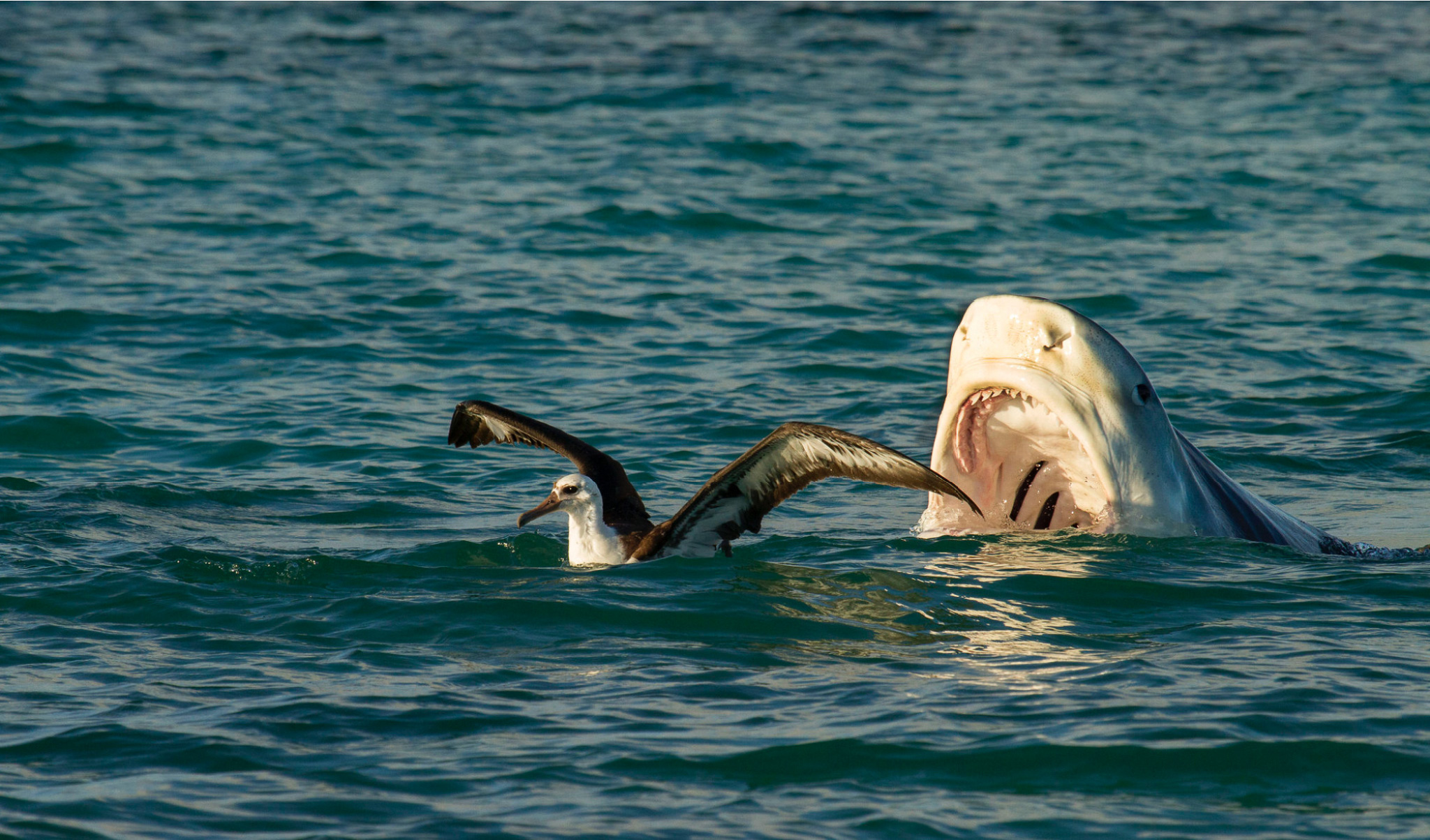It’s rare that predatory animals like sharks have just meat in their stomachs. While most sharks primarily prey on fish, marine mammals, and other sea life, they’re still indiscriminate predators who accidentally consume stuff that’s not exactly edible. For millennia humans have lost, wrecked, or purposely dumped all kinds of stuff in the ocean. That includes everything from clothing and jewelry to priceless artwork and ancient artifacts. And given that the our modern oceans are full of plastic, metal, and general flotsam and jetsam, the stuff you can find inside a shark’s stomach increasingly resemble the contents of a dumpster.
That’s why examining the contents of a shark’s gut is such an interesting pursuit, particularly for anglers, marine biologists, and even forensic specialists. We can’t resist a good shark story, so we rounded up of some of the wildest items — and body parts — found inside sharks’ stomachs throughout history.
Why Do Sharks Eat Garbage?
Photo by Reinhard Dirscherl / Getty Images
Before we dive into the roundup of the weird stuff sharks eat, let’s get a better idea of why sharks end up eating all this junk in the first place (and how they survive the indigestion).
Most marine species are showing increasing signs of eating plastic, metal, and other non-food refuse. As those materials enter the marine food chain, they work their way up to apex predators like sharks. In other words, when sharks eat fish they eat everything that fish has eaten, which helps explain some of the smaller trash, microplastics, and other oddities found inside a shark’s stomach.
But as the following list demonstrates, sharks will sometimes just eat trash outright. In fact, certain species of sharks are more prone to eating garbage than others. Tiger sharks, for example, are nicknamed the “trash cans of the sea” because they’ll lock their serrated teeth around just about anything. While tiger sharks are known as one of the top species responsible for unprovoked attacks on humans, we also know that sharks tend to explore their surroundings with their mouths. They have sensitive nerve endings in their teeth and often their exploratory bites can cause fatalities (in humans, for instance) or result in an unnatural meal. (Remember, the odds of dying from a shark attack today are extremely rare: Just one in 4.3 million, according to the International Shark Attack File at the Florida Museum.)

Photo by Stefan Irvine / Getty Images
Luckily, shark stomachs contain acids that are strong enough to eventually dissolve metal, according to the Hawaii Department of Land and Natural Resources. Some species are even capable of pushing their stomachs inside out, rinsing them, then putting them back in place. But neither of these strategies helped sharks digest some of these truly outlandish stomach treasures we have discovered throughout history.
The Weirdest Stuff Ever Found Inside a Shark
A Suit of Steel Armor

Photo by Francisco Daum / Flickr
A 1994 New York Times article reported on a traveling shark exhibit that appeared at the American Museum of Natural History in New York. Part of the exhibit featured items found inside shark stomachs over the years. One of the items on display was a replica of a full suit of steel armor with a helmet.
Related: Great White Shark Tales from Cape Cod Captains
A 16th century French physician named Guillaume Rondelet recorded this discovery in his Libri de Piscibus Marinis, or “Summary of Marine Fishes” after finding the armor in a dead great white shark. Both the location of the find and how the armor ended up in the water in the first place remain mysteries.
Fur Coats

Speaking of protective outerwear, that 1994 shark exhibit also had a fur coat on display. But this wasn’t the only known instance of sharks eating coats. According to Shark! Killer Tales from Dangerous Depths by Robert Reid, the early 20th century Australian surgeon and author V.M. Coppleson spoke of a tiger shark found off the coast of the Adriatic Sea that had consumed not one, not two, but three overcoats — plus a nylon raincoat for good measure.
License Plates

Photo by Jerry Woody / Flickr
The trope of the shark eating the license plate was popularized after the 1975 release of — what else — “Jaws,” during which Richard Dreyfuss pulls a Louisiana plate out of a tiger shark’s stomach during a post-mortem. (Theories circulate around the license plate being a nod to the James Bond series with the “007” at the start of the plate number, as Spielberg wanted to work on the British spy movie series but was turned down.)
A real license plate (from Florida) has been found inside real shark’s stomach, and it was also on display in that 1994 exhibit. Some anglers hypothesize that metal license plates resemble giant metal fishing lures, which trigger a fish’s predatory response. There are also a lot of license plates out there, so it’s not surprising that that sharks have eaten their fair share.
One Tattooed Human Arm

Photo via National Library of Australia
In 1935 a tiger shark was hooked from an Australian beach and taken to the Coogee Aquarium and Swimming Baths in Sydney. It was hard to miss it when the shark regurgitated a whole, heavily-tattooed human arm into the aquarium. The discovery of the distinctive arm started what would become a monthslong murder investigation involving a boxer-turned-billiards-club owner named James Smith. Smith had disappeared mysteriously that April after having lied to his wife about going fishing.
Instead, he had gone to a beach cottage to visit a buddy known to be involved in petty crime. After an insurance scam fell through, investigators theorized that Smith’s buddy murdered and dismembered Smith, then packed him in a barrel and tossed him out to sea. (It’s not clear if the barrel broke apart at sea, a shark bit into the barrel itself or, perhaps strangest of all, the arm simply didn’t fit into the barrel and was tossed overboard.)
Smith may have met an unfortunate end, but his resting place inside a shark’s stomach is far from unique. Human remains have been found inside more than just one shark. We know sharks have eaten plenty of humans over the centuries; what’s remarkable is catching one before it digests its meal.
An Entire Reindeer

Few sharks would be capable of swallowing a mature reindeer whole. Great white sharks come to mind, but their ranges don’t exactly overlap with that of a reindeer. So leeave it to the Greenland shark, the world’s longest-living vertebrate that swims in the North Atlantic and Arctic oceans, to swallow reindeer whole, along with parts of a horse. Greenland sharks are known to feed on carrion and are often attracted to smelly spots like commercial fishing operations.
Greenland sharks can live up to 400 years. While they are largely understudied due to their remote and reclusive nature, they are considered a globally vulnerable species. They can grow to some 21 feet long and weigh up to 2,255 pounds.(This video of Swedish kayak angler Joel Abrahamsson catching and releasing one weighing 1,225 pounds is worth watching.) A fisherman named Terje Nordtvedt caught the IGFA all-tackle Greenland shark record in Trondheimsfjord, Norway on Oct. 18, 1987. The shark weighed 1,708 pounds 9 ounces.
An Unopened Bottle of Wine
In 1942 the crew of a French fishing trawler found an old bottle of Portuguese madeira wine in the stomach of a 6.5-foot blue shark. Madeira is a fortified wine made in the Portuguese islands of the same name. According to Atlas Obscura, madeira was often made and aged on transatlantic ships headed from Europe to the North American continent, which drove a high demand for it. With this much wine constantly at sea, it’s unsurprising that a bottle ended up overboard. The French fishermen allegedly sampled the booze and found it to be in perfectly drinkable condition.
Dogs (Collars, Leash, and All)

Photo by James D. Morgan / Getty Images
Coppleson, the doctor who wrote about the disembodied arm in Sydney, also extracted the front half of a bulldog with a leash around its neck from a tiger shark found in Sydney Harbor. The bulldog was accompanied by limbs from several different stock animals, including pigs, sheep, and even chunks of horse. Coppleson also discovered a different tiger shark off Bondi Beach (near Sydney), whose stomach contents included a mature spaniel dog with a collar still fastened around its neck.
Migrating Songbirds
In 2017 a study published in the research journal Ecology revealed that baby tiger sharks in the Gulf of Mexico were overwhelmingly eating songbirds as they migrated over the large expanse of ocean. Mississippi State University researcher Marcus Drymon led a team of scientists to catch and pump the stomachs of some 107 baby tiger sharks before releasing them into their home waters. Of those sampled specimens, 41 of them had remnants of songbird meals past.

Photo by Ilana Nimz / NOAA Fisheries
“Tiger sharks will see an easy meal and snatch it up, but I was surprised to learn that the sharks were eating songbirds — I assumed that they’d be seabirds,” co-author Kevin Feldheim told Science Daily of the study. Drymon added, “None of them were seagulls, pelicans, cormorants, or any kind of marine bird.”
Other Strange Things Sharks Have Eaten
It’s impossible to rattle off all the weird stuff ever to meet its end inside a shark’s stomach (who knows what they’ve digested in the depths of the oceans). Here are a few other honorable mentions:
- An unopened can of salmon
- A green iguana from the Galapagos Islands
- A leather wallet
- A coil of copper wire
- The propeller from an outboard motor
- A bison hide
- A keg of nails
- Porcupine spines
Final Thoughts

Photo by G.P. Schmahl / NOAA
Sharks are curious creatures that explore their surroundings using all of their senses and abilities, and that means biting with their mouths. Sharks both accidentally and deliberately eat all kinds of surprising items, particularly as trash continues to pile up in our oceans. Fortunately, they have iron-clad stomachs that can often dissolve even the toughest meals, including metal.
